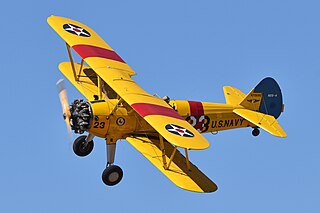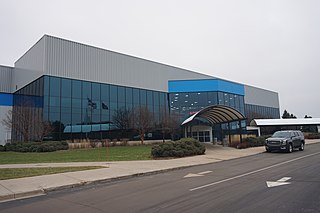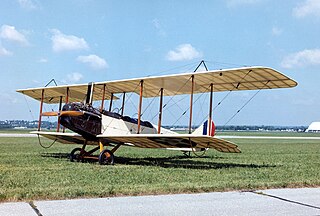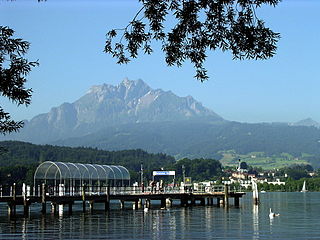
Pilatus, also often referred to as Mount Pilatus, is a mountain massif overlooking Lucerne in Central Switzerland. It is composed of several peaks, of which the highest (2,128.5 m [6,983 ft]) is named Tomlishorn.

The Curtiss JN "Jenny" was a series of biplanes built by the Curtiss Aeroplane Company of Hammondsport, New York, later the Curtiss Aeroplane and Motor Company. Although the Curtiss JN series was originally produced as a training aircraft for the US Army, the "Jenny" continued after World War I as a civilian aircraft, as it became the "backbone of American postwar [civil] aviation".

The Sikorsky H-19 Chickasaw is a multi-purpose helicopter that was used by the United States Army and United States Air Force. It was also license-built by Westland Aircraft as the Westland Whirlwind in the United Kingdom. United States Navy and United States Coast Guard models were designated HO4S, while those of the U.S. Marine Corps were designated HRS. In 1962, the U.S. Navy, U.S. Coast Guard and U.S. Marine Corps versions were all redesignated as H-19s like their U.S. Army and U.S. Air Force counterparts.

The Vultee BT-13 Valiant is an American World War II-era basic trainer aircraft built by Vultee Aircraft for the United States Army Air Corps, and later US Army Air Forces. A subsequent variant of the BT-13 in USAAC/USAAF service was known as the BT-15 Valiant, while an identical version for the US Navy was known as the SNV and was used to train naval aviators for the US Navy and its sister services, the US Marine Corps and US Coast Guard.

The Stearman (Boeing) Model 75 is an American biplane formerly used as a military trainer aircraft, of which at least 10,626 were built in the United States during the 1930s and 1940s. Stearman Aircraft became a subsidiary of Boeing in 1934. Widely known as the Stearman, Boeing Stearman, or Kaydet, it served as a primary trainer for the United States Army Air Forces, the United States Navy, and with the Royal Canadian Air Force as the Kaydet throughout World War II. After the conflict was over, thousands of surplus aircraft were sold on the civilian market. In the immediate postwar years, they became popular as crop dusters and sports planes, and for aerobatic and wing walking use in air shows.

Hans Erni was a Swiss graphic designer, painter, illustrator, engraver and sculptor.

The Bell 47 is a single-rotor single-engine light helicopter manufactured by Bell Helicopter. It was based on the third Bell 30 prototype, which was the company's first helicopter designed by Arthur M. Young. The 47 became the first helicopter certified for civilian use on 8 March 1946. The first civilian delivery was made on 31 December 1946 to Helicopter Air Transport. More than 5,600 Bell 47s were produced, including those under license by Agusta in Italy, Kawasaki Heavy Industries in Japan, and Westland Aircraft in the United Kingdom. The Bell 47J Ranger is a modified version with a fully enclosed cabin and tail boom.

The Convair C-131 Samaritan is an American twin-engined military transport produced from 1954 to 1956 by Convair. It is the military version of the Convair CV-240 family of airliners.

The Magyar Műszaki és Közlekedési Múzeum, still often referred to with its former name, Közlekedési Múzeum, is a museum in Budapest, Hungary. It is one of Europe's oldest transportation collections.

The Air Zoo, founded as the Kalamazoo Aviation History Museum, is an aviation museum and indoor amusement park next to the Kalamazoo-Battle Creek International Airport in Portage, Michigan. The Air Zoo holds many historical and rare aircraft, including the world's fastest air-breathing aircraft, the SR-71B Blackbird. Many of its antique planes are airworthy. Among its other attractions are a 180-degree theater that projects a 2-D film simulation of a B-17 bombing mission during World War II; and various amusement rides, including flight simulators of a rocket trip to Mars, a U.S. Navy F/A-18 Hornet, a stunt biplane, a hot air balloon, a veteran U.S. Navy F-14A Tomcat that served aboard USS America, and more. Air Zoo is a Smithsonian Affiliate.
The Dakota Territory Air Museum is an aviation museum on North Hill in Minot, North Dakota near Minot International Airport. The mission of the Dakota Territory Air Museum is to be a historical aviation resource honoring the men, women and machines that have impacted the rich history of aviation through displays and events that educate, inspire and entertain people of all ages. The museum consists of a main information room, outdoor displays, a restoration hangar, the Scott Nelson Gallery, the Texas Flying Legends hangar, Wright Flyer Hangar and the Oswin H. Elker Hangar.

The Standard J is a two-seat basic trainer two-bay biplane produced in the United States from 1916 to 1918, powered by a four-cylinder inline Hall-Scott A-7a engine. It was constructed from wood with wire bracing and fabric covering. The J-1 was built as a stopgap to supplement the Curtiss JN-4 in production.

The Dufaux 5 was a two-seat airplane built in 1910–11 by French-Swiss aviation pioneers Henri and Armand Dufaux.

The Auguste Piccard mesoscaphe, also known simply as the Mésoscaphe, was a manned underwater submarine designed in 1964 by Jacques Piccard, son of Auguste Piccard. It was the world's first passenger submarine, built for Expo64, the 1964 Swiss national exhibition in Lausanne. It was built at the Giovanola fabrication plant in Monthey and the first immersion took place in Le Bouveret on 27 February 1964. It has a total of 45 Plexiglas portholes, with 20 on each side for the 40 passengers.

The Lucerne–Immensee railway line is a railway line in Switzerland that connects Lucerne with Immensee, the starting point of the Gotthard railway. It was built by the Gotthardbahn-Gesellschaft (GB) and opened on 1 June 1897 as the approach from Lucerne to the Gotthard railway. With the nationalisation of the Gotthardbahn on 1 May 1909, the line became the property of the Swiss Federal Railways.

Luzern Verkehrshaus railway station is a railway station in the city of Lucerne, in the Swiss canton of Lucerne. It is an intermediate stop on the standard gauge Lucerne–Immensee line of Swiss Federal Railways. The station is directly adjacent to the Swiss Museum of Transport. Connections to the Lake Lucerne Navigation Company's ferries on Lake Lucerne are available at the Verkehrshaus-Lido landing stage on the other side of the museum from the station.

Verkehrshaus-Lido landing stage is a landing stage in the city of Lucerne, Switzerland. It is located on Lake Lucerne, across the bay from main part of Lucerne. It is served by the Lake Lucerne Navigation Company. The port is adjacent to the Swiss Museum of Transport ; rail connections are available at Luzern Verkehrshaus railway station, on the far side of the museum.





















